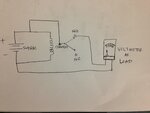p72
Member level 3

Hi,
I am searching for the Relay (SPDT) that can take 24VDC on coil and it switches contact from NC to NO. (output voltage on "NO" should be the same 24Vdc) Can anyone suggest me relay?
One more question, can i use the same voltage on "Common" terminal of the relay which is applied on the coil of the relay?
Please see attached diagram.
Thank you,
p72

I am searching for the Relay (SPDT) that can take 24VDC on coil and it switches contact from NC to NO. (output voltage on "NO" should be the same 24Vdc) Can anyone suggest me relay?
One more question, can i use the same voltage on "Common" terminal of the relay which is applied on the coil of the relay?
Please see attached diagram.
Thank you,
p72


